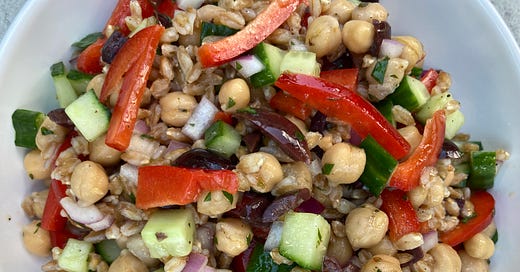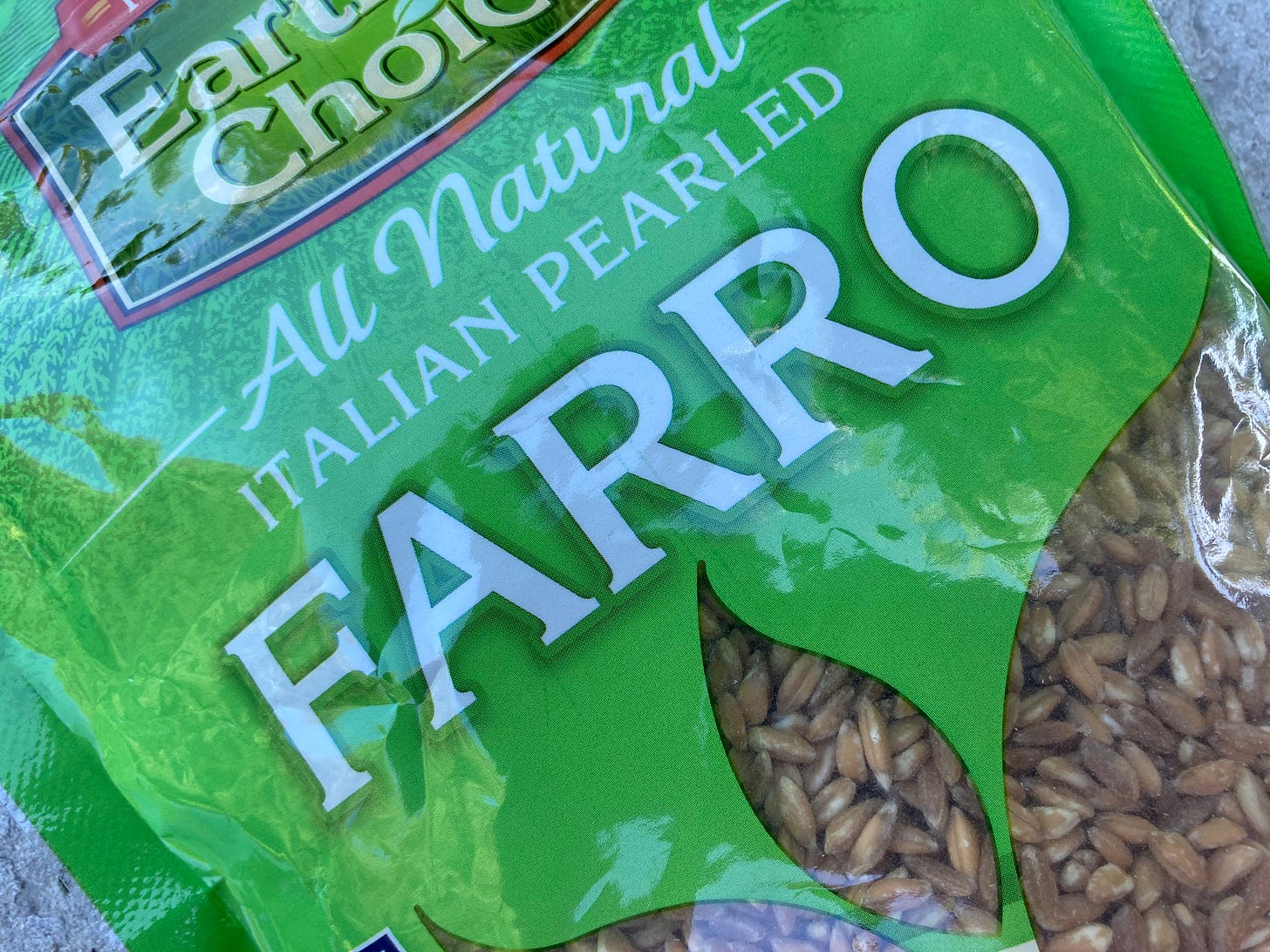Summer Farro Salad
A crisp and colorful combination of vegetables come together with fiber-packed farro. Take this unique and delicious salad to your next picnic potluck.
If you’ve been trying to add more whole grains to your diet but have had your fill of brown rice and quinoa, let me introduce you to farro.
One of the earliest cultivated whole grains, farro (pronounced FAHR-oh) is a type of wheat. Also referred to as emmer wheat, this grain has a very mild, slightly sweet flavor. When cooked, farro should be tender, with a bit of chew. It should not be mushy.
Farro comes in three forms – whole grain, semi-pearled, and pearled.
Whole-grain farro is the most nutritious variety due to its outer bran layer being left intact. A 1/2-cup serving of cooked whole-grain farro provides 5 grams of dietary fiber. Because of the bran layer, it does require overnight soaking to soften the grain. It also takes longer to cook, about 40 minutes.
Semi-pearled farro has some of the bran layer removed and supplies about 4 grams of dietary fiber per 1/2 cup cooked serving. Cooking time is reduced to about 25 minutes and no soaking time is needed.
Pearled farro has all the bran layer removed. A 1/2 cup cooked serving still provides 3 grams of dietary fiber, which is slightly more than brown rice. Cooking time is reduced to about 20 minutes, with no need to presoak.
When it comes to shopping for farro, chances are pretty good that you’ll only find pearled. In the lead up to testing this recipe, I shopped two grocery stores (major chains), one natural food market, and one Italian specialty market and pearled farro was the only variety available.
In the kitchen, farro is incredibly versatile as it adopts the flavors of other foods. It’s a great addition to hearty soups, stuffings, pilafs, rice dishes, and chilled grain salads like today’s recipe. It makes a perfect base for Buddha bowls and even serves as a replacement for arborio rice in risotto. Made with farro, risotto becomes “farrotto.”
One cup of dry farro typically yields about 3 cups cooked. Unlike rice, farro usually won’t absorb all the cooking water and should be drained once the desired texture is reached.
Before using any variety of farro, sort through the grains, discarding bits of chaff or tiny pebbles, and rinse it well in a fine-mesh strainer. The best way to store dry farro is in an air-tight bag or container in a cupboard or pantry. If storing longer than three months, place sealed farro in the refrigerator or freezer.
To your health,
Darlene
SUMMER FARRO SALAD
Yield: 10 servings
Serving Size: 1/2 cup
Prep: 15 minutes
Ready: 40 minutes
INGREDIENTS
2/3 cup dry pearled farro
1 1/2 cups water
1 can (15 ounce) chick peas, drained and rinsed
1 cup julienned red bell pepper
1 cup diced seedless cucumber
1/2 cup diced red onion
1/2 cup kalamata olives, roughly chopped
1/4 cup red wine vinegar
3 tablespoons olive oil
1 tablespoon fresh snipped parsley
1 teaspoon sugar
1 teaspoon Dijon mustard
1 teaspoon dried oregano
1 clove garlic, minced
1/4 teaspoon kosher salt
1/4 teaspoon black pepper
DIRECTIONS
To prepare farro, place in a fine-mesh strainer and rinse under cold water. Add water to a saucepan and bring to a boil. Add rinsed farro and reduce heat to medium-low. Cover with a lid and let simmer for 20 to 25 minutes or until desired doneness. Rinse cooked farro under cold water and drain well.
In a large bowl, combine drained farro, chick peas, red pepper, cucumber, red onion, and olives. In a small bowl or measuring cup, whisk vinegar, oil, parsley, sugar, mustard, oregano, garlic, salt, and black pepper until well combined.
When ready to serve, pour dressing over vegetables and gently toss to combine.
Nutrition Information per Serving
142 Calories, 7 g Total fat, 1 g Saturated fat, 0 g Trans fat, 0 mg Cholesterol, 180 mg Sodium, 18 g Total carbohydrate, 3 g Dietary fiber, 2 g Total sugars, 0 g Added sugars, 4 g Protein, 0 mcg (0%) Vitamin D, 18 mg (2%) Calcium, 1 mg (6%) Iron, 189 mg (4%) Potassium
© 2022 RECIPES MADE HEALTHY BY DARLENE ZIMMERMAN, MS, RD LLC







